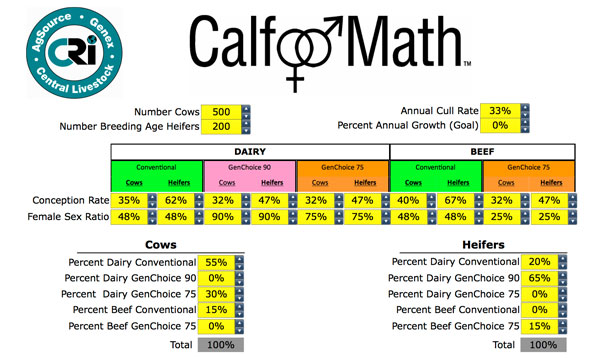How many replacement heifers does your dairy really need? Do the math with Calf Math. This free-to-use web tool from Genex Cooperative calculates heifer needs based on a herd’s targeted cull rate and growth rate, with adjustable parameters to fit the individual dairy. Genex’s Kristi Fiedler, associate vice president of U.S. technical services, discusses how and why to use this online estimator.
Q: What is the web address?
FIEDLER: Calfmath.crinet.com
Q: Why was it developed?
FIEDLER: Dairy farm pregnancy rates have been climbing in recent years due to many factors, such as improved cow comfort, synchronization programs and genetics. With the combination of good reproductive performance and the use of sexed semen, dairy producers are facing a new situation on their farms: too many heifers.
The Genex Cooperative Inc. Calf Math program was developed to help dairy producers determine the number of heifer calves they need to produce each year and to build a breeding strategy to meet their herd goals.
Q: Who should use it?
FIEDLER: The basic Calf Math calculator is available to the public and can be used by dairy producers or consultants. If a dairy would like further information on profitability of different breeding strategies including cost of semen, current beef cross prices and genetic gain, they should contact their local Genex representative.
Q: Is there a cost to use it?
FIEDLER: The Calf Math tool on the website is absolutely free. Producers can utilize the more in-depth version alongside a Genex representative. This version enables the producer to sit down and discuss herd parameters, goals and strategies.
Q: What are some unique features?
FIEDLER: Calf Math is available to any herd size. It was the first program of its kind to look at using several types of semen products including conventional semen, sexed semen and beef semen and to account for the difference in conception rate by semen type. Calf Math is customizable because it is based on each herd’s performance and goals.

Q: How does it work?
FIEDLER: Calf Math is quite simple. First, a dairy producer determines his/her future plan by defining a target cull rate and growth rate. The next step is to input farm data such as number of cows, conception rate, stillbirth percentage, calf loss and so on. The calculator then shows the number of replacements currently being obtained and the number needed to reach the defined goals. The last step is to adjust the semen types used to meet the target number of replacements desired each year.
Q: Why is it important to understand or utilize?
FIEDLER: It is expensive to raise extra replacements and often causes a bottleneck on the farm if there isn’t enough room to raise those animals. Also, when a large number of replacements are available, producers often cull heavily from the milking herd to make room for the heifers.
The most profitable cows on the farm are those in their second lactation or higher; they have already paid for their raising costs and should be the higher producing animals. Selling these cows early may not be the best solution for long-term profitability.The goal behind Calf Math is not only to determine and build a strategy around the individual farm’s goals, but to also optimize farm profitability.
This is done by getting the best replacements possible and by choosing to produce replacements from the top genetic merit animals. Lower genetic merit cows can be bred to beef semen and the resulting beef cross calves sold for a premium. PD

Peggy Coffeen
Editor
Progressive Dairyman







